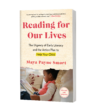Award-winning author Toni Morrison is well known for her powerful writing that examines the black experience in America, with a particular focus on women and girls. Both a Nobel Prize and Pulitzer Prize winner, she is best remembered for her classic novels The Bluest Eye (1970) and Beloved (1987), which was later adapted into a movie with Oprah Winfrey’s support. Her vast and impressive body of work includes 11 novels, nine non-fiction books, two short stories, and two plays.
What many people don’t know about Morrison is that her works also include eight children’s books that she wrote along with her son, Slade Morrison. These delightful and whimsical stories explore a variety of themes that will make excellent conversation starters during family read-alouds. You can use them to spark reflection, and ask your children how they relate to the stories. Check out our post on read-aloud styles to learn about the importance of interaction during story time. In addition to engaging your child in discussion around the books’ themes, and building on their questions about the stories, you can also point to sight words or letters your child may recognize as you go through the pages. This develops their print awareness, a key pre-reading skill.
Children’s Books by Toni and Slade Morrison
Let us know if you’ve read these books with your child and which are your favorites!
By Chrysta Naron
One March a few years ago I was teaching Pre-K and had hit a teaching wall. I felt like I had exhausted my whole arsenal of reading activities. My students were bored of the same small-group activities as they progressed from learning letters to reading simple words. I didn’t know what to do to spice things up.
Cue Cara. Cara, one of my students, showed up one day and proudly showed me a bag of her newest treasure: chocolate gold coins to share with the entire class. Rather than simply hand them out, Cara threw them up overhead at Circle Time and shouted, “It’s Patrick’s Day treats!”
As my little friends began laughing and scurrying for coins, it struck me how much fun we could make reading with the use of a shiny treat. And leprechaun gold goes with rainbows! If you run with the five-year-old set, you’ll know: Rainbows. Are. Everything. Thus Pot O’ Vowels was born! It’s the perfect St. Patrick’s Day game that helps kids practice reading while having fun.
You’ll find detailed instructions below, but first, let’s look at why this kind of activity is so great for learning.
How This Game Develops Reading Skills
What’s unique about this activity is that it develops children’s phonemic awareness. Phonemic awareness is the ability to isolate a single sound in a word. Rather than just sounding out a word, a child has to listen for a specific sound in a specific spot to play this game. Phonemic awareness can be a tricky thing to learn and a tricky thing to teach, but Pot O’ Vowels is a literacy activity that helps break it down in two ways.
- We use consonant-vowel-consonant, or CVC, words. This means a three-letter word that starts with a consonant, has a vowel in the middle, and ends with a consonant. Words like BAT or KID. These words are usually ones children are familiar with and can easily sound out. (The longer the word, the harder it is to find a single sound within it.)
- We focus only on the vowel sound. This makes the target something stable and limited. There are only 5 vowels, compared to 21 consonants, and we’re only using the “short” vowel sounds. It creates a lot of combinations, but really focuses the skill for a child.
Bonus: This game is also really inexpensive! I went to the dollar store and got everything for $3! And it only takes a few minutes to set up. Talk about the Luck of the Irish!

Materials:
- Gold coins (plastic or chocolate)
- Small black pots (or any opaque container)
- Markers or crayons
- Tape
- Paper
- Packing tape (optional)
Cost: $3
Step 1: On a sheet of paper, help your child draw a rainbow with thick bands of color. Make sure your rainbow has at least four stripes. Then repeat on a second piece of paper.
Tip: You can also print or draw a blank rainbow template and let your kiddo color it in.

Step 2: On each band, write the first and last letter of some three-letter CVC words that your child is familiar with. Here are some suggestions:
C _ T (can go with CAT, CUT, or COT)
D _ G (can go with DOG, DIG, or DUG)
S _ N (can go with SUN or SON)
B _ G (can go with BAG, BIG, BOG, BEG, or BUG)
H _ T (can go with HAT, HOT, or HIT)
S _ T (can go with SIT, SET, or SAT)
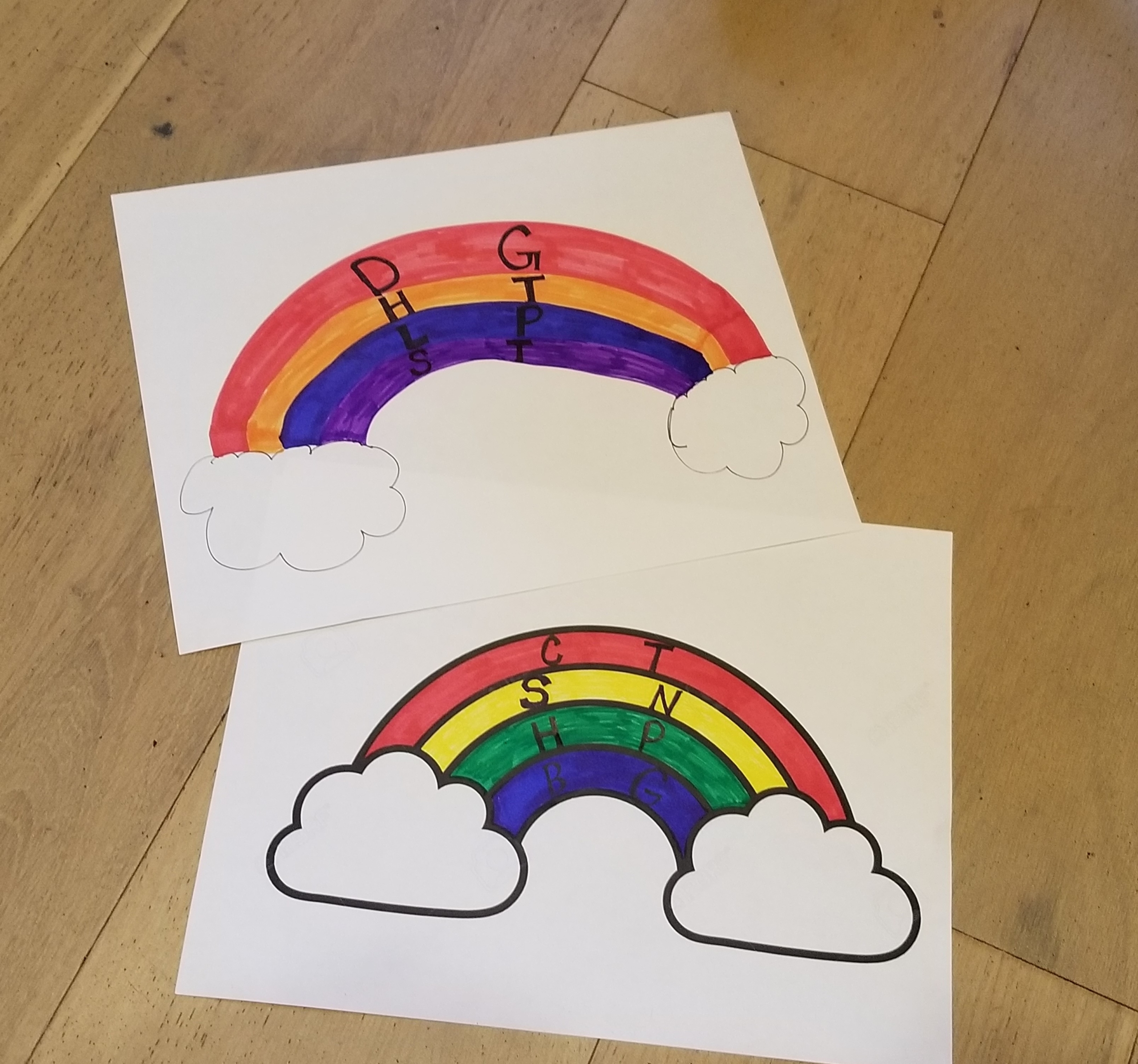
Step 3: Using a permanent marker, write one of the five main vowels (A, E, I, O, U) on each gold coin. Make sure that there are multiples of each vowel. You can use either plastic coins or chocolate ones; the choice is up to you.
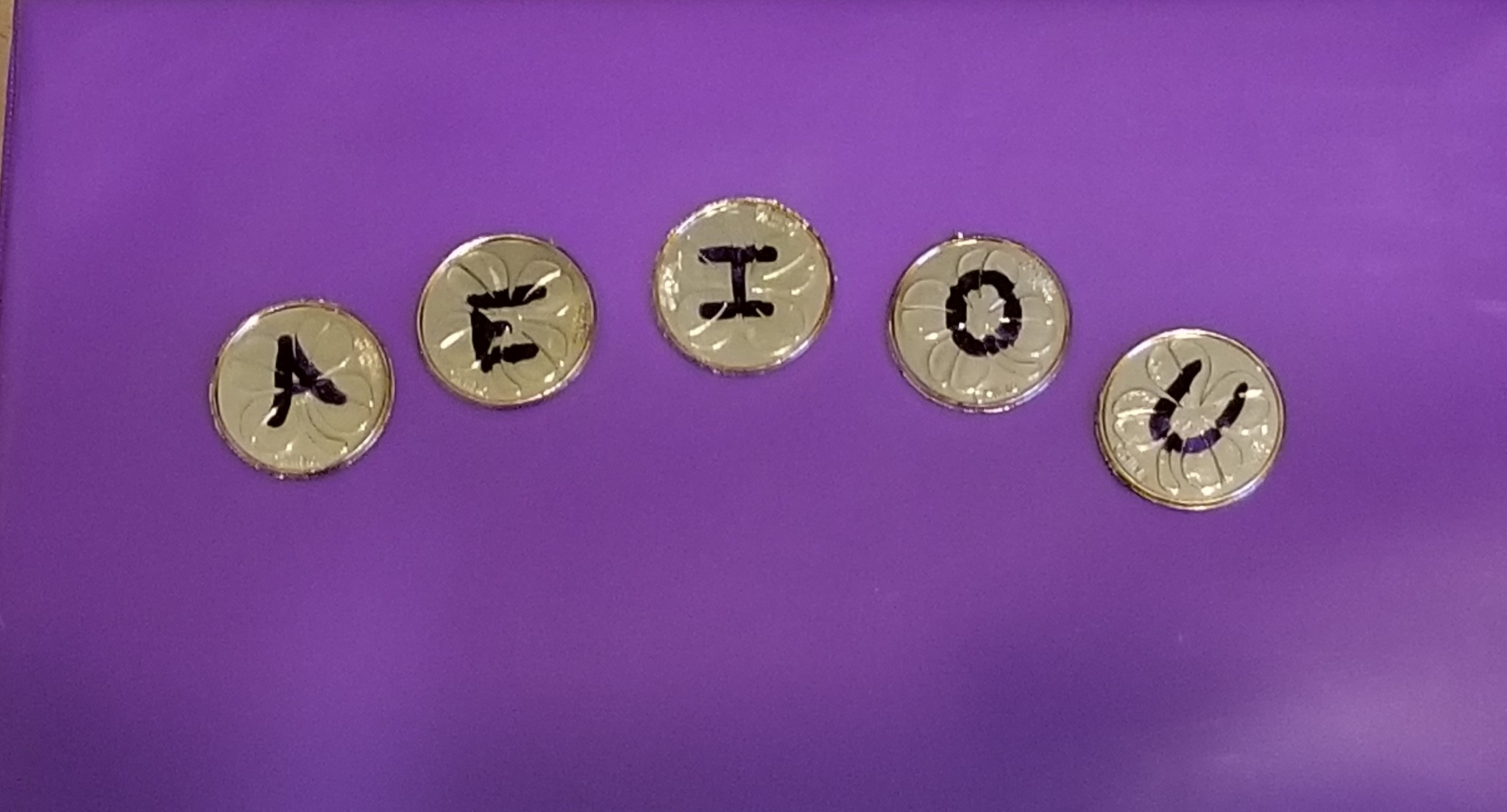
Step 4: Place the gold coins in the black pot. Now you have a Pot O’ Vowels! Any non-transparent container will work if you’re unable to buy the pots.
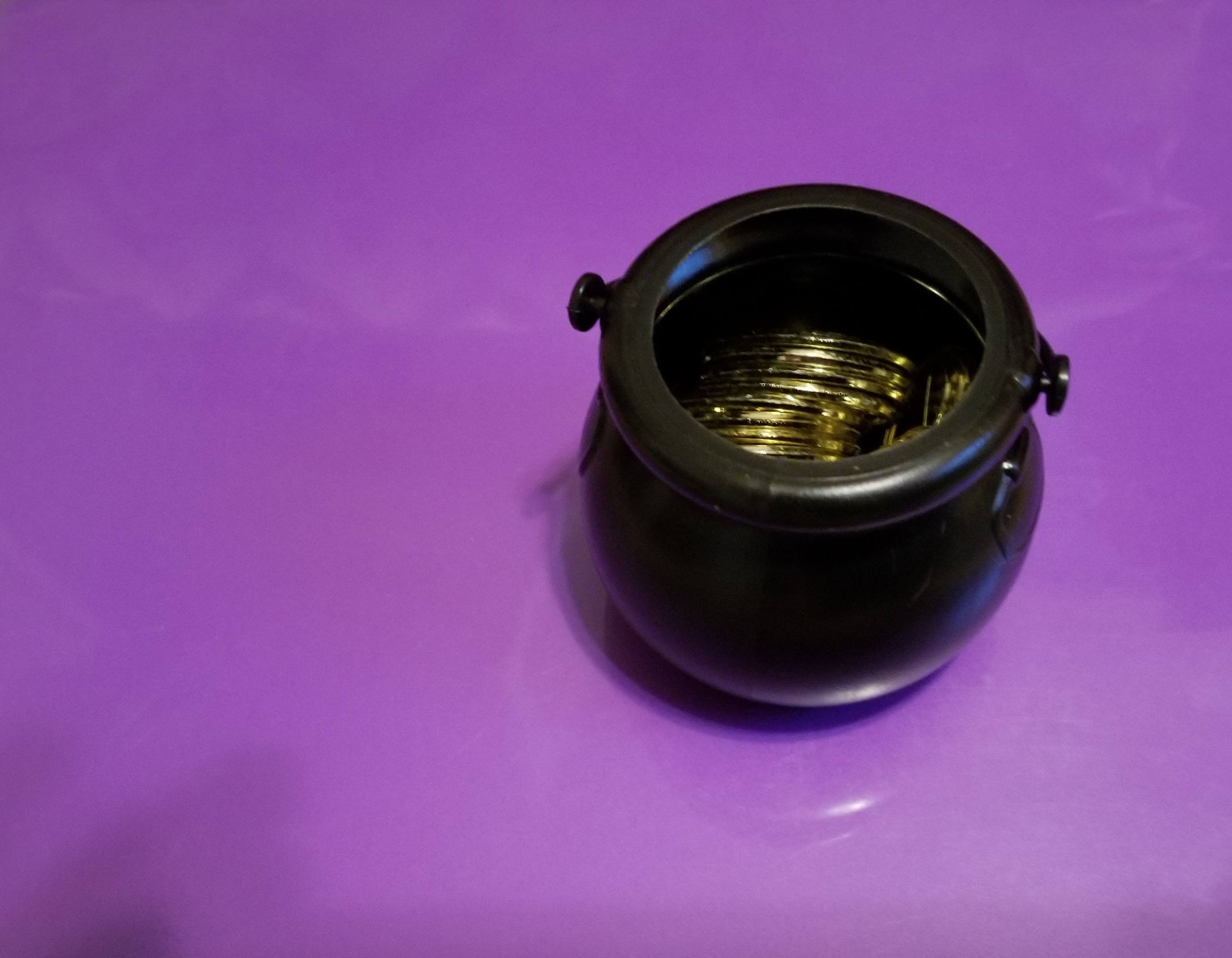
Step 5: Each player takes turns drawing a coin from the Pot O’ Vowels. Use the vowel coin to try to create words on your rainbow. The first player to have a rainbow full of words wins!
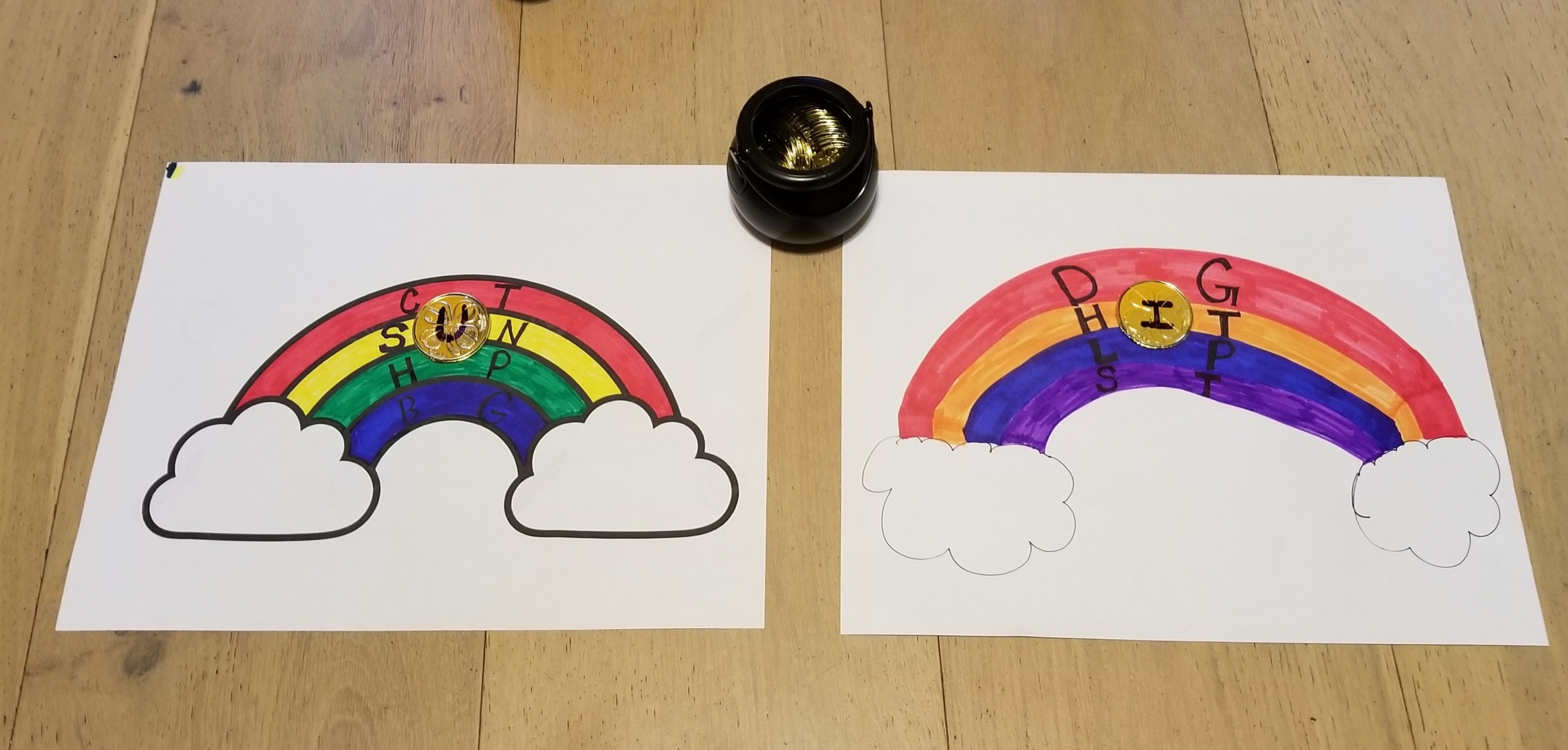
If your child loves this game, make it permanent using this old teacher trick. Cut out the rainbow and cover both sides in packing tape. It’s low-cost lamination that will keep those cards safe from wear and tear.
Upgrade: Is your little leprechaun a pro at CVC words? You can make this game more advanced by choosing words with Y as the vowel, like FLY or TRY. Or create words that have a silent E, such as B_KE (which could be bike or bake).
Turn reading time into playtime? I-rish you would!
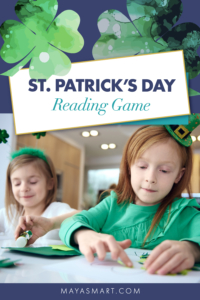
By Chrysta Naron
Have you ever looked at an uppercase A? Really looked at it? It’s tall, angular, and has nice long lines. Now look at a lowercase a. It’s short and round and sometimes even has a little hood on top. You might think, “How are these two symbols the same letter?”
Well, your young child is probably thinking the exact same thing. It’s important for us to help kids learn the connection between uppercase and lowercase letters—that these two symbols are actually one and the same letter!
There are so many creative ways you can accomplish this through play. I love to use food and cooking to teach, but all parents know that where little chefs go, mess follows. Luckily, young children just love pretend play. So I’ve cooked up a little literacy activity that keeps kids entertained in the kitchen while teaching the connection between uppercase and lowercase: “no-bake letters!”
Note: Check out the end of this post to find easy ways to adapt this activity for kids who are ready to move on to practicing letter sounds or even to spelling out simple words.
Cost: Free if you already have alphabet magnets and these other simple materials. If you don’t have letter magnets yet, they’re well worth adding to your teaching arsenal. You can pick up some basic ones for just a few dollars.
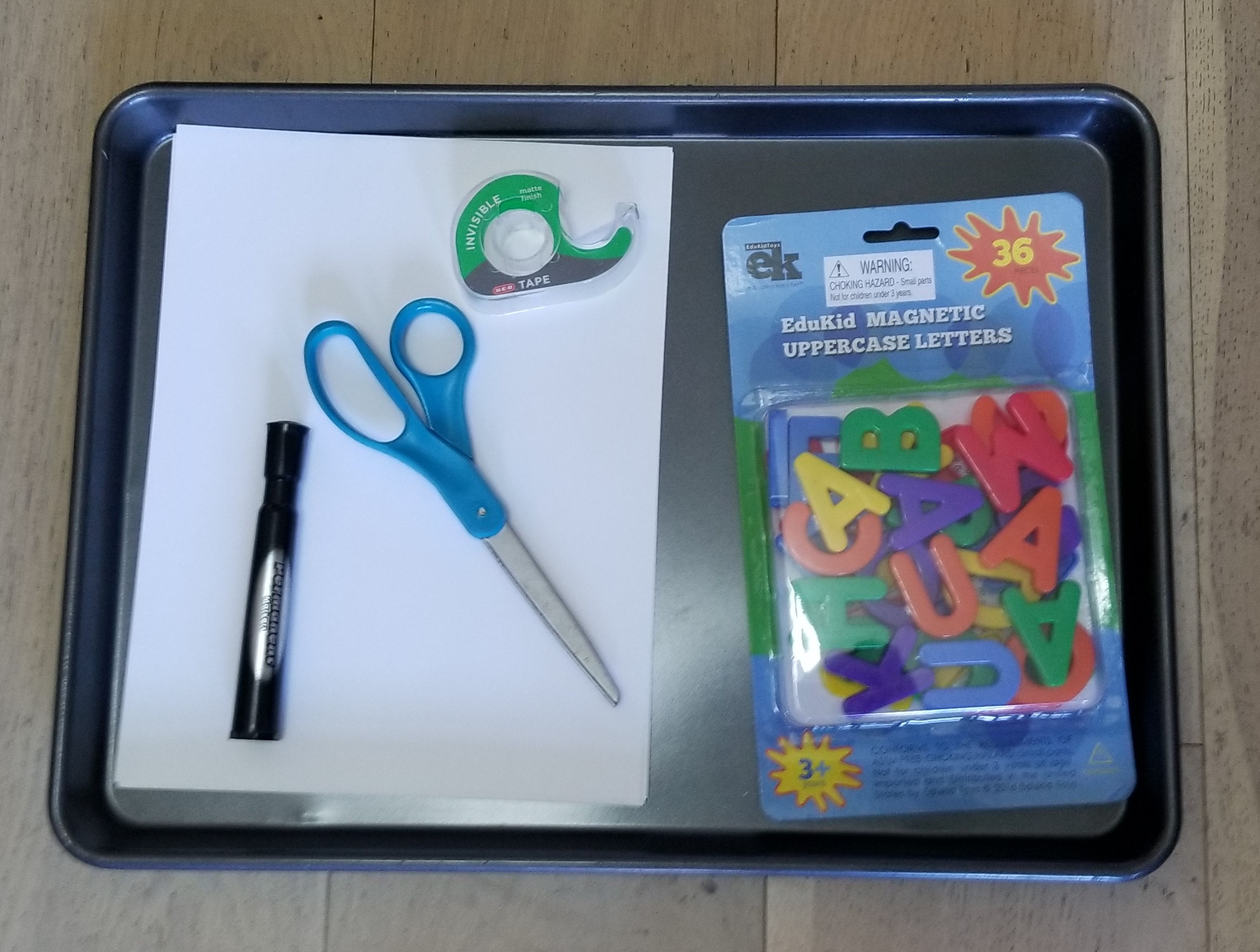
Materials Needed:
- Alphabet magnets
- Metal cookie sheet
- Paper
- Marker
- Tape
- Printer (optional)
Step 1: Write all 26 lowercase letters on a piece of paper. Optional: You can also type them up and print them out if you like. (Check out here why Comic Sans is the best font to use!)
Step 2: Cut out each letter individually.
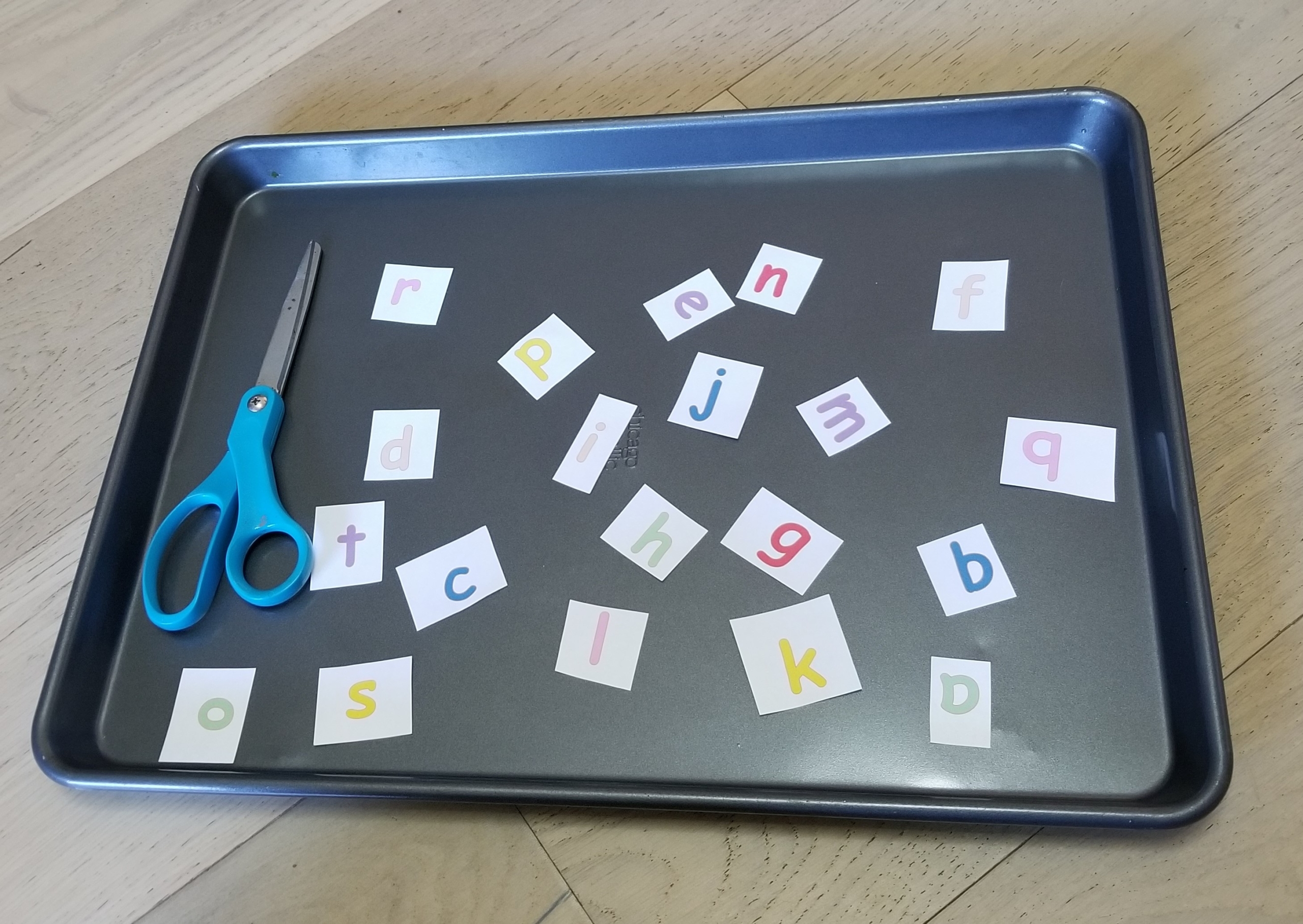
Step 3: Tape each letter to the cookie sheet. For younger children, place the letters in alphabetical order. For more advanced readers, feel free to mix them up and place them all over the sheet.
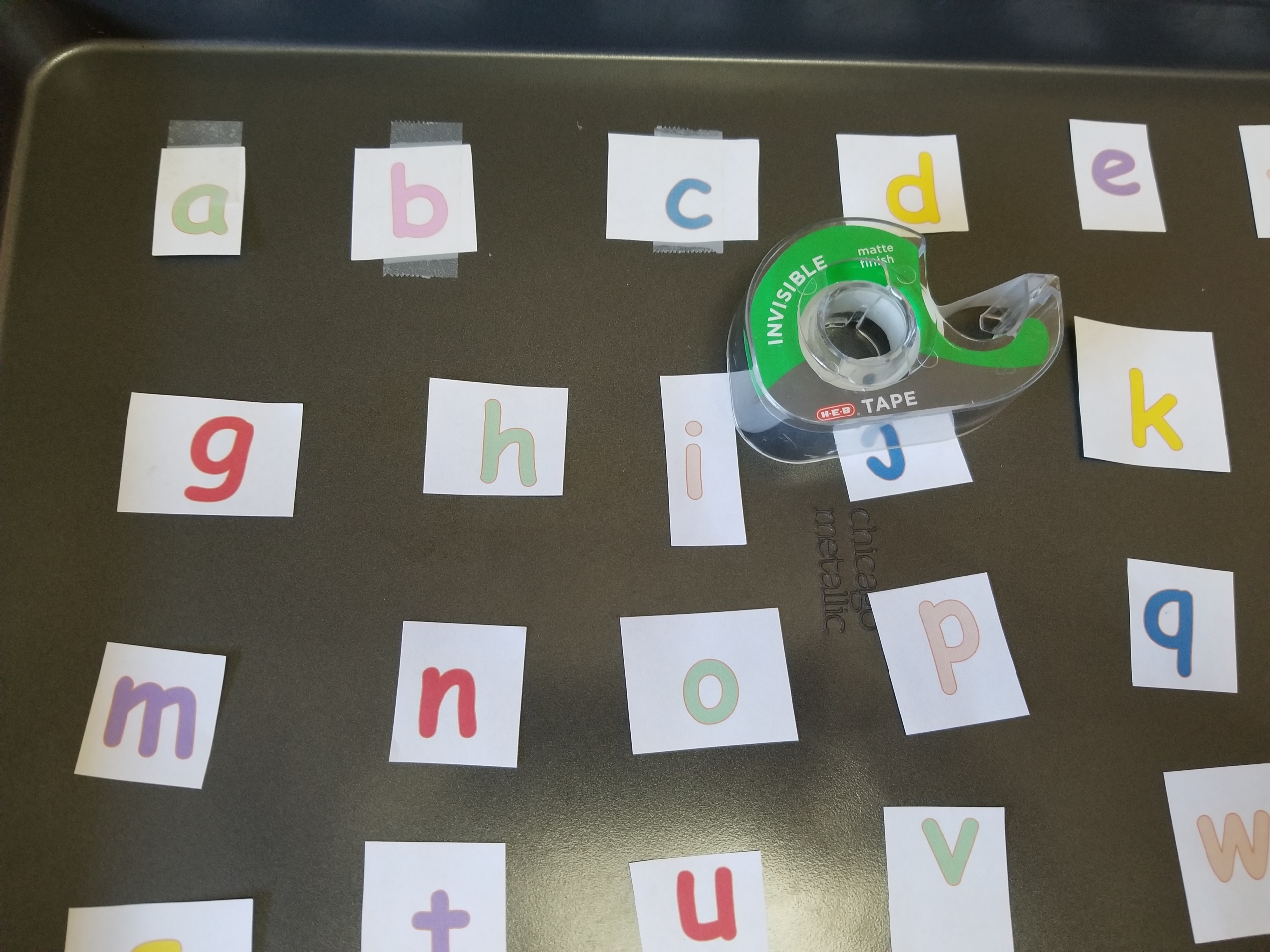
Step 4: Time to play! Optional: To spice up this activity, you can invite your preschooler to don an apron and maybe even a chef’s hat to make their own no-bake letters.
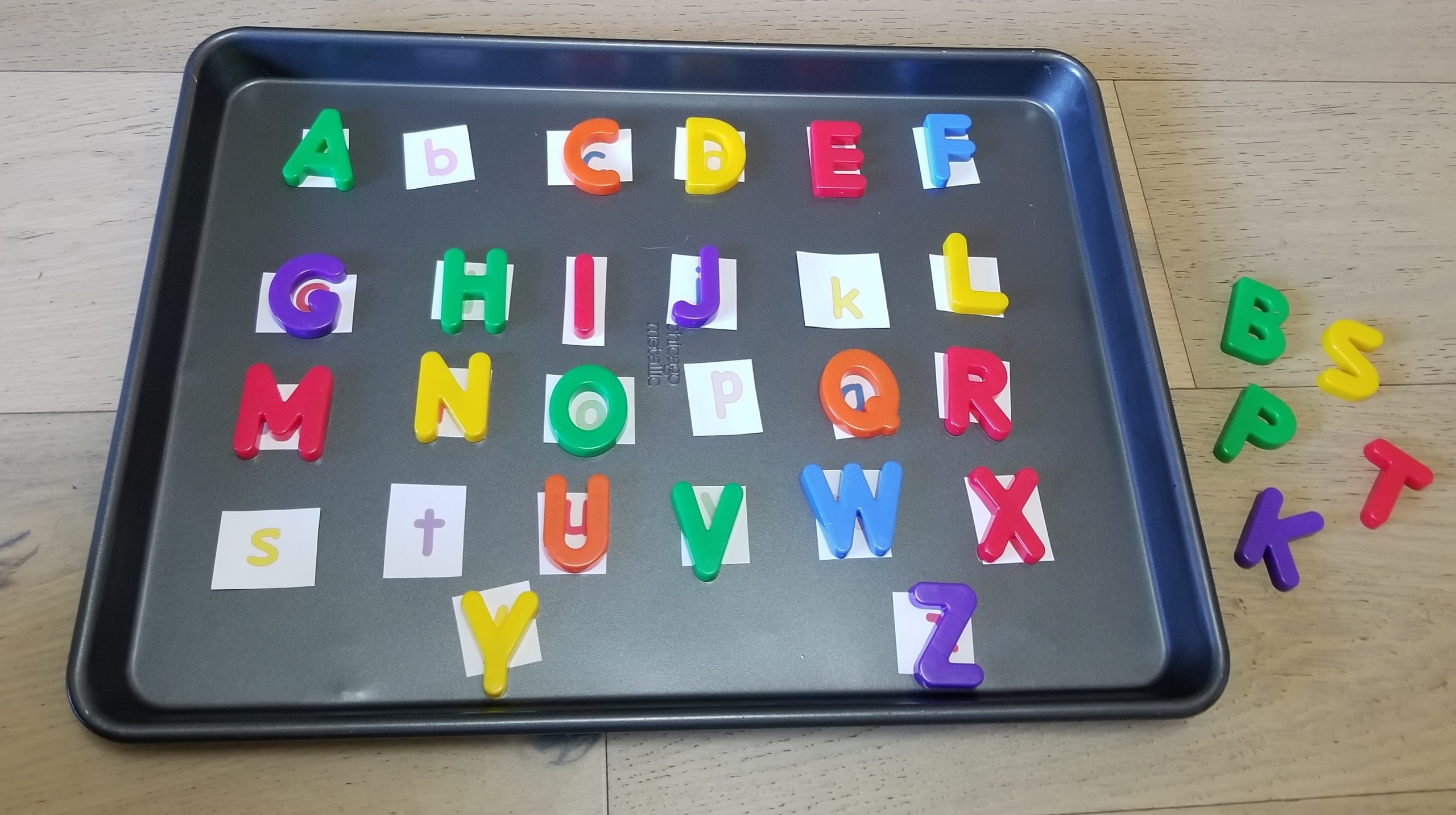
Give your child the uppercase alphabet magnets. Now, have them match each uppercase magnet to the same lowercase letter. Thanks to the magnet, the uppercase letters will stick in place on top of the lowercase ones!
If you have a play kitchen, let them stick the cookie sheet in the pretend oven to “bake” their answers once they’ve matched all the magnets. (No play oven? No problem. You can create your own from an old cardboard box. Just cut a door in the side that pulls down, then let your child decorate it.)
Adaptations
What if your child already knows the alphabet? Fear not! I have a couple of handy adaptations right here: Print pictures of everyday objects, animals, etc., and have your child match the alphabet magnet to the picture that begins with the first sound. Try it again, this time matching the last sound of a word.
You can even ask your more advanced writer to spell out the names of the objects with the magnets! Just remember that for this version, you’ll need to pick words that don’t have any double letters.
More than anything, this activity is one that is quick for you to create and keeps your child learning as they age. These are important reading skills and making no-bake letters is a fun way to help your child acquire them. No muss, no fuss! Just lots of learning fun.
*Featured photo by Andrea Alexander
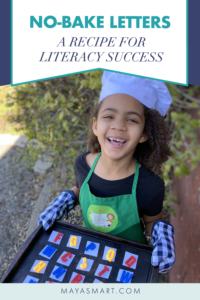
As we spend more time at home, it’s increasingly common to feel isolated and lonely. Many of us, parents and children included, are spending less time socializing with our friends and families, and more time feeling more disconnected from others. This is especially true for older adults, particularly those in assisted living facilities and nursing homes.
If you’re looking for an easy at-home literacy activity for your child, writing a letter or card to a senior is a perfect opportunity! Not only does it offer great motivation and practice for your budding writer, but it’ll also help make isolation a little easier to bear for someone who could use a friend. In the process, it builds kindness and mindfulness in children, allowing them to experience the transformative power of serving others.
If you don’t have a senior in mind already (or have a prolific letter-writer ready for more correspondents), there are several organizations that connect children to seniors and others who may be lonely. See the end of this post for a list of groups.
Who Benefits When Kids Write Letters to Seniors?
Everyone! There’s just something special about receiving a handwritten note or card in the mail. Letters can hold a sentimental place in our hearts, and unlike emails or texts, recipients can put them on display to cherish. For seniors who are isolated, receiving a hand-written note also shows that someone out there cares and took time to make something to brighten their day.
For children, letter writing is an engaging activity that lets them explore their creativity and learn to express themselves. My daughter loved to review her finished letters with pride as she prepared to share her creations with friends and loved ones. Along the way, they’re building and practicing key literacy skills.
Crafting cards and letters requires kids to create words and pictures, organize them in a meaningful way, and successfully communicate ideas to others. As your child sits down to compose a letter, they’ll practice handwriting, vocabulary, spelling, and self-expression.
Writing letters to seniors is also a great way for kids to give back from the comfort of their homes, as they learn the value of empathy and service through connecting with others. Getting out of their own heads, gaining perspective, experiencing gratitude, and learning the joy of giving will contribute to their own mental health and resilience for years to come—not to mention making them better citizens of our world.
Suggested Topics
The best part about this literacy activity is that your child can be creative! Even the youngest kids can participate, by drawing a picture and signing their name. Here are some topic suggestions to get your little pen pal started:
- Draw or color a picture to share your artistic talent.
- Share an original poem or short story.
- Talk about a recent event that was important to you.
- Send a card to celebrate a holiday.
- Recap your favorite book.
- Share a special memory or story.
Letter-Writing Organizations
If you’re writing to a senior through an organization, be sure to check their guidelines before you begin. Some offer one-way communication only, for example, and some request that you exclude the date. Others specify only cheerful, encouraging notes to lift a recipient’s spirits.
Love For Our Elders was founded in 2013 by a teenager inspired by his grandfather. To honor his grandpa’s memory, the teen started volunteering at nursing homes. He began writing handwritten letters to residents with no visitors. Since then, his one-person mission has grown to more than 50,000 volunteers across 70 countries working together to fight loneliness with love. Love for our Elders also created “Letter to an Elder Day,” celebrated each year on February 26.
More Love Letters is an international organization that uses the power of social media to get people to write and mail love letters to people in need all over the world. Volunteer writers can read nominations of recipients and choose which to respond to. You also can nominate someone who needs a little love and support.
Saffron and Shreya Patel founded Letters Against Isolation in early April 2020. As teenagers who had been calling their self-isolating grandparents every day, they sought to spread some joy to residents of assisted living facilities and care homes. Every other week, you’ll get a spreadsheet where you can sign up to send letters to care homes in the U.S. and abroad. Your kids can write as many letters as they like!
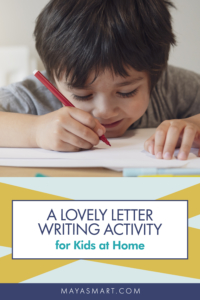
By Karen Williams
Of all of the ways we can encourage learning and development in children, reading aloud to them is one of the simplest and most effective. Reading picture books to even the youngest children builds their vocabulary and comprehension. But what it doesn’t do, at least not automatically, is help them connect the lines on the page (which are so much less eye-catching than the illustrations) with the words they’re hearing.
To get the most out of story time, we need to draw kids’ attention to the letters and words on the page, in addition to the pictures—what’s known as “print referencing.” This easy tweak can make all the difference in helping listeners bridge towards readers. And few texts are better adapted for print referencing than Mo Willems’s popular picture books, with their comic-book style illustrations and speech bubbles.
You may even already be practicing print referencing without realizing it! Let’s delve in a little deeper to see how you can best leverage this super-easy but super-powerful tool for seeding reading.
What is Print Referencing?
Most simply, print referencing is pointing out text as you read aloud. Research has shown that, when presented with books, children are more likely to focus on the pictures on each page than the words. With print referencing, we draw their attention from the pictures to the words. This allows children to develop the awareness that we’re actually reading the text, not describing the pictures. This technique encourages several literacy skills as children get older, including language development, spelling, pronunciation, and pattern recognition.
The beauty of print referencing is that it is so easy to do, yet can have such an outsized impact on literacy. Here are some ways you can use print referencing during read-alouds with your children.
Trace or underline words as you read. No expensive kits or fancy accessories necessary! The key tool for print referencing is the simple yet effective index finger. By underlining words as you read to children, you focus their attention on the print itself, rather than just the pictures. Your kids will also learn about the pacing of a story, including when to pause or emphasize certain points. Older children may even notice that you pause at a period or exclaim at an exclamation point.
Identify any print in pictures. Although the focus here is the printed words making up the story, there may be pictures that contain words, too. For example, a book may have a sign that says STOP! These also offer great opportunities for print referencing. The key here is to identify the actual words used within the picture, as some children may be able to recognize the picture’s meaning without necessarily recognizing the words themselves.
Look for letters and sight words they recognize. As children develop literacy skills, they’ll begin to notice letters and words they’ve seen before. Encourage them to point out any they remember or recognize. You can also engage them with the text by asking questions like, “How many As do you see on this page?” or “Can you spot any letters you know?”
Print Referencing with Mo Willems’ Books
You can (and should) use print referencing with practically any picture book on your children’s shelves, but New York Times bestselling author-illustrator Mo Willems has written some of the best ones for pointing out words during read-aloud sessions. Willems borrows classic comic-book elements like speech bubbles and strips of illustrations with integrated text, and adapts them perfectly for the very youngest audiences. The simple, eye-catching pictures and easy-to-read print offer many opportunities to practice print referencing.
So what are you waiting for? Grab a Willems book—anything from the Elephant & Piggie series will serve perfectly, as will one of the popular Pigeon books—warm up your index finger, and get print referencing!
Resources for Parents:
The official Mo Willems website: Learn more about the author and his book collection, plus find suggested activities to go along with the stories.
7 Guaranteed Ways to Engage Kids with Family Read-Alouds
5 Reading-Aloud Tips to Get Your Child Kindergarten Ready

The book traces the jagged rise of the iconic writer, from a spunky young girl soaking up the front-porch tales of her neighbors in Eatonville, Florida, to a brilliant storyteller and conservator of black culture, language, and experience in her own right as an adult.
Williams nods to the landscapes, people, and circumstances along the author’s uphill journey, but Hurston seems to provide her own momentum, leaping toward new places, experiences, and dreams without undue concern that she could fall to the ground. Rather, the book recounts how she took her mother’s encouragement to “jump at the sun” to heart—to Howard University to Harlem to Haiti and beyond, with little more than gumption to sustain her.
My husband and I named our daughter, Zora, after the pioneering writer, so I was thrilled to discover a book that could extend her knowledge of her namesake’s life and legacy.
Now nine years old, our Zora was enamored with the book from its opening pages. Beyond the obvious enjoyment she took in seeing her name repeated so many times in print, our Zora said she was inspired by Hurston’s ability to overcome obstacle after obstacle in the pursuit of her dreams. It’s true that the brilliant writer kept “jumping” in circumstances that would have narrowed most folks’ vision to just clawing out an existence on the ground.
Hurston’s legacy as a literary powerhouse blazes on with this biography for young readers. Fans of all ages can return to the book again and again to contemplate the questions it raises about familial obligation, the high cost of education, independence and patronage in the arts, the preservation of cultural heritage, and more. And parents in particular will love its poignant depiction of how a mother’s encouragement can provide lifelong inspiration.
Why do you think a Hurston biography is fitting for young audiences? Do you have a favorite biography that you read as a child or to a child?
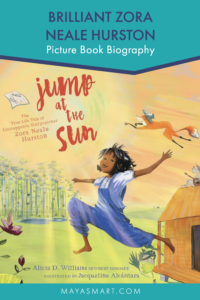
Do you catch yourself scrolling mindlessly on Instagram before bed or in the carpool line? Good news: You can turn your scrolling into a literacy-building activity for your kids! In a happy, literary corner of the internet, #bookstagram accounts offer an easy way to find reading recommendations and discover new authors.
Instead of the clothing hauls and makeup tips many online influencers share, “bookfluencers” are a vast collection of literacy advocates, book lovers, parents, and educators offering reviews and “book shelfies.”
With more than 50 million posts under the hashtag #bookstagram on Instagram, there are endless accounts to discover. We rounded up some of our favorites that share kids’ reads, so you can scroll and support your child’s literacy at the same time.
Here Wee Read – @hereweeread
Charnaie Gordon’s background is in computer programming but literacy is clearly her passion. The manager behind the popular Here Wee Read and 50 States by 50 Books accounts, Gordon also hosts a “bookish podcast dedicated to celebrating diverse and inclusive books for kids and adults.”
On Here Wee Read, you can find themed lists of children’s books—like “10 Black History Board Books for Tiny Readers”—along with peeks inside her favorite picture books and book-themed giveaways. Gordon says that, rather than “othering” diverse books or promoting books just for girls or for boys, she hopes her accounts foster the idea that all books are for everyone.
Helping Kids Rise – @helpingkidsrise
If you’re building a more inclusive home library, Helping Kids Rise is a great source of inspiration. Since 2016, the account has been sharing children’s books that “educate, empower, and affirm,” so you have years’ worth of recommendations to add to your shopping cart or library waitlist. Here, you’ll find books for all ages that feature role models and trailblazers throughout history.
Indigenous Bookshelf – @indigenousbookshelf
The Indigenous Bookshelf Instagram account highlights books by American Indigenous authors, with a focus on amplifying these voices in literature. While the account doesn’t exclusively feature children’s books, it frequently recommends picture books and middle-grade titles, offering a valuable resource for parents, educators, and young readers. The account also shares insights into Indigenous-owned bookstores, encouraging followers to support Native American businesses. Through well-curated recommendations, Indigenous Bookshelf promotes authentic representation in literature, helping to broaden the understanding of these cultures and stories across all age groups.
Maya Lê – @MaiStoryBookLibrary
Maya Lê’s Instagram account is a treasure trove for parents, educators, and book lovers, especially those seeking to expand their children’s literary world. With a focus on reviewing children’s picture books, Maya consistently highlights stories by diverse authors and illustrators, offering readers a rich selection of voices and perspectives. She regularly curates themed booklists, making it easy for her followers to discover new titles that align with their interests or specific topics they want to explore with young readers. Maya also shares engaging content on her YouTube channel and offers creative activities on Teachers Pay Teachers, making it easy for families and educators to deepen the reading experience. Her account is a valuable resource for promoting diverse storytelling and fostering a love of reading in young children.
Vera Ahiyya – @thetututeacher
Vera Ahiyya is an educator and children’s book author known for promoting inclusive and anti-bias education. On her social media accounts she shares books, classroom ideas, tips for educators, and resources focused on building empathy, community, and diversity in education. Vera has written a wide variety of children’s books, including You Have a Voice, which encourages children to speak up for themselves and others. Her work emphasizes the importance of social-emotional learning and antiracist education, helping children feel confident in their identities while fostering positive change through the power of their voices.
Megan Reid – @ihaveabook4that
Megan Reid’s Instagram account offers a fresh and thoughtful approach to discovering children’s books. She specializes in recommending stories that open up important conversations, from celebrating diversity to exploring emotions. Megan’s carefully compiled selections help parents find books that not only entertain but also encourage learning and connection. Whether you’re searching for bedtime stories, tales that spark imagination, or books that reflect different cultures, her recommendations are accessible and meaningful. Following her account gives parents a reliable resource for finding stories that enrich their children’s reading experience and foster a love of books.
The Kid Lit Mama – @thekidlitmama
Elizabeth Mundt, aka The Kid Lit Mama, shares colorful videos on social media that share great children’s books resources. Parents and educators can expect lively, carefully selected content that inspires kids to dive into stories. While her videos are a highlight, she also offers additional resources and tips through her blog, making her platform an all-around valuable tool for fostering a love of reading.
Reading With Red + the Magpie – @readingwithredandthemagpie
Run by a homeschooling mother of two, this account shares inclusive book recommendations, often centered around themes of identity, environmentalism, and civil and social rights. Her thoughtfully chosen reading selections create opportunities for important conversations with children about the world around them. This account is a wonderful resource for parents seeking to broaden their kids’ perspectives and foster a love for books that promote social awareness and responsibility.
Maya Smart – @mayasmarty
Don’t forget to check out MayaSmart.com on Instagram! Connect with Maya to scroll through our latest literacy activities for parents and kids, to celebrate authors with us, to get book reccs, and much more. Our mission is to help your family read well to live well. Whether you’re expecting your first child or are well along in your parenting journey, we’re here to help you raise strong readers who will change the world.
Finally, also be sure to follow your local library if it’s on Instagram! So many have accounts with book recommendations and updates about community events like story times or book clubs.
P.S. Did you add one or two … or maybe 20 … books to your wish list after checking out these accounts? Consider getting them from a local bookstore or a black bookstore.
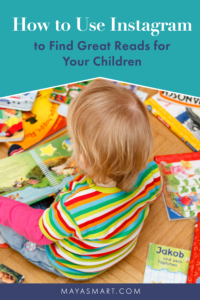
Kelli Mason, a mom of two and the vice president of diversity, equity, and inclusion at Notley, a social impact investment firm, has labored for years in the notoriously reactive workplace diversity space. But her latest project, Ripple Reads, looks upstream to address racism before it takes root in the next generation. The monthly family newsletter she founded aims to get parents and their little ones excited to stand up for racial justice.
“If we can reach kids proactively and get families to get comfortable having honest conversations about race, then we might be able to actually move the needle, and work ourselves out of business in the workplace inclusion world,” she says. “We’ll help raise this generation of kids to become adults who don’t need to be educated on race, racial justice, and racial awareness.”
The publication offers in-home antiracist parenting curriculum for discussing race with children, developed by Dr. Keffrelyn Brown and Dr. Anthony Brown of the Center for Innovation in Race, Teaching, and Curriculum at the University of Texas. More than offering mere talking points, the curriculum provides book recommendations, discussion guides, activities, and other content aimed at planting antiracist principles into the hearts of families. And starting in 2021, it’s entirely free, so everyone can be equipped to have frank family discussions about race with elementary school-aged kids.
What inspired you to start Ripple Reads?
So really, it was over summer of 2020, when George Floyd was murdered, and there was this national and, really, global recognition that we are not where we think we should be as a society when it comes to race. A lot of parents [were] reaching out and saying, “Our kids are hearing about this in the news. Our kids know that something’s going on. They’re seeing Black Lives Matter signs pop up around the neighborhood. How do we engage them in a way that is age-appropriate?”
And we loved that challenge. Being in this workplace diversity and inclusion and racial justice space, a lot of it is reactive. It’s if someone did something bad at work and they said something wrong, and now we need to figure out how to make it right. It’s dealing with adults who are very hard to change, if you’ve got these deeply ingrained biases.
What reactions have you gotten from parents? And have you been surprised by anything?
I have been surprised by how voracious kids are for this conversation. So many people have been like, “Oh my gosh, my kids can’t wait to have these discussions and they just want to ask question and question and question.” I think that there are a lot of people who—race was kind of a taboo, particularly white families, more like you never talked about it. But kids see it, and now they’re like, “Oh my gosh, I can talk about it? Wow, that’s exciting.”
Another one that’s come up is for black families. It’s something interesting I’ve talked with Dr. Keffrelyn Brown about a lot. They’re like, “This is scary. This could be scary for my kids. Right now my kids are in this bubble and they don’t know that police can do these horrible things, and I want to keep them in that bubble.”
The feedback I got from Keffrelyn is that talking about race and racism can help kids of color, black kids in particular, build up this resilience and this awareness to say, “Oh, when these things are happening outside in the world, it’s not personal. It’s not about me. It’s about the systemic structures that have been in place for hundreds of years.” And, “That’s their problem and they need to figure that out. I’m not the problem.” So I thought that was an interesting approach.
And how has your approach to parenting or your reflections on how you were parented been affected by these experiences?
It’s funny, because my dad read my little bio about why I started Ripple Reads on the website and he was like, “I didn’t know you felt that way.”
I had a black mom and a white dad, and they really were like, “Color doesn’t matter. You can do anything you want.” Just very, rah, rah, color blind, we don’t see color.
And as I’ve gotten older, I’m like, wait. When we don’t acknowledge that color is there, as kids it’s easy to start telling yourself these stories, like, “Well, if color doesn’t matter and this isn’t a thing, then why are all the people on the rich side of town white and all the people on the poor side of town or the homeless people black?”
And so you start creating these stories like, “Well, they must have some personal shortcoming that has led them there.” You lose the bigger picture that systemic racism is a thing and it still exists. We’re still dealing with the consequences of it every day.
And again, back to what Keffrelyn said, it takes the personal out of it, right? It’s not that for whatever reason, black people aren’t deserving of nicer homes or whatever. No, actually, there’s been an exposé in Long Island, just a few years ago, that real estate agents today are still steering black people to certain neighborhoods and white people to certain neighborhoods.
And there was this couple, also a biracial couple, a black woman and a white man. The woman got the home appraised and the husband was like, “No, no. Our home should be appraised much more than this.” He sends her away. He’s like, “You go. I’m going to talk to the appraiser and stuff,” took down all of their family photos so that the appraiser didn’t know that this was a biracial family, got the house appraised for $100,000 more.
There’s all of these things that are still going on today. So I think it’s important that we have these conversations, and that was kind of what was lacking in my own upbringing, this, “What is the bigger picture? What systemic things are going on in it?”
These are definitely things I’ll do differently with my kids.
In doing a project like this, you have to have a certain level of optimism that personal conversations can lead to systemic, larger, bigger, sea-change kind of transformation. Is conversation enough? What else do you think people need to do?
We always include activities, because conversation is kind of the first step. And I love this quote from Angela Davis: “In a racist society, it’s not enough to be non-racist. You have to be antiracist.” I think that the conversations, they’re enough to say, “Hey, we can be non-racist.” But then with the activities and the content that we put around it, it’s, “How can you take that next step?”
We had, in the September issue, [an activity]: If your kid comes home and they’re like, “Oh, someone called someone the N-word on the playground.” I think a lot of parents, regardless of your background, might be like, “That wasn’t nice,” “Don’t play with that kid anymore,” “We’re not inviting that kid over to our house.”
And that’s great. You’re not participating and you’re not the one calling somebody this. But the next step is, go talk to the teacher, talk to the kid’s parents, talk to the principal, whatever makes sense. Take that next step to show your kids that we’re not just not a racist family. We’re not just a family that is passively, “Oh, that’s not good. We don’t do that.” We’re a family that takes action.
I think once there are enough families that are having this conversation and then taking that action and feeling empowered to speak up, that’s when the systems can change. That’s the hope.
Have you gotten any indications or feedback yet from families that are taking action, or do you think people are in a stage of still taking it all in and having the conversations privately at home?
We’ve had a few. People will send in pictures. One of the activities we had was to do a Black Lives Matter sign and you could put it in your window. The kids are getting involved and they’re creating this thing.
With the act of creating, they’re feeling ownership over it. So we have some pictures of their kids doing that and pictures of the signs up in their windows.
Have I heard anyone talk to a principal or make systemic change yet? I know it’s still early, but hopefully so, right? I think these are the stepping stones, the building blocks, so that you feel comfortable in that place, because it’s become your identity.
I think that’s what we want. We want families to have this identity of “we’re going to take action,” so that when rubber hits the road and there’s an opportunity to take the action, you’re going to do it.
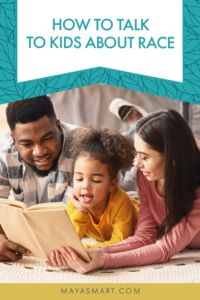
To set kids up for long-term success and get them kindergarten-ready, it’s important to introduce them to letters and words early and often. Repetition is key to really fixing these all-important squiggles into their memories, as is exposing them to letters in a variety of contexts.
But as any parent knows, small children have a whole lot of energy to let out of their systems. Getting our little ones outside keeps them healthy and happy—and offers a welcome shot at tiring them out enough for an early bedtime. So sitting at a table to tackle endless alphabet worksheets or expecting them to sit still for long read-alouds doesn’t always feel like an option.
That’s why we’ve rounded up some of our most popular posts about how to reinforce literacy learning while getting kids out and active at the same time. All of these activities are super simple and affordable, requiring only basic materials.
So follow the links below for inspiration to blend some crucial early literacy practice into outdoor time with your kids. Then enjoy the fresh air as you get a little exercise alongside them!
Awesome Alphabet Hopscotch
Alphabet Hopscotch provides important alphabet knowledge and letter sound practice—all while reinforcing gross motor skills and getting kids some much-needed exercise and fresh air.
But most of all, this easy alphabet game from early childhood educator Chrysta Naron is a fun way to bolster literacy while on the move with wriggly kids. This game can come to life in just a few minutes. All you need is a single piece of chalk.
In this post, Chrysta shares how to use hopscotch to teach both letter names and letter sounds—two key and very distinct steps towards reading and writing. She also describes how to play indoors, so you can still enjoy some active learning play if conditions keep you inside.
The Ultimate Outdoor Scavenger Hunt
Try this letter scavenger hunt to engage kids and have family fun outdoors. Getting outside, moving around, and boosting letter engagement is a win-win-win. What’s more, this simple and completely free activity builds mindfulness and strengthens your bond with your child. Strolling together at a leisurely pace provides a welcome break from technology and a chance to notice your surroundings.
This article from contributor Karen Williams gives tips and ideas for taking your child on a literacy scavenger hunt around the neighborhood, plus suggests three scavenger hunt books for kids in different age groups. Karen recommends a variety of ways to customize your hunt, including adaptations for older kids.
Alpha-Bingo Gets Kids Moving and Learning
Early childhood educator and literacy specialist Chysta Naron offers a twist on the literacy scavenger hunt: alphabet bingo. In this simple literacy game, you and your child will make real-world connections to the letters they’re practicing, all while exploring your neighborhood together.
Chrysta offers up educator-tested tips for maximizing your child’s letter learning, suggestions on which letters to focus on first, and directions for playing with multiple children. You’ll also find a printable alpha-bingo card to get you started. (No printer? Not a problem. You can always make your own, of course. Bonus: Making your own card offers a chance to help your kiddo write the letters.)
Take a Nature Walk Story Time
Get yourself and your child some fresh air, exercise, and important nature exposure—and enjoy the cuddles and literacy learning of reading aloud at the same time.
Just pack a picnic, a blanket, and some picture books (bonus if they’re about animals, nature, science, or other outdoors topics). Then head out to a natural area or park. Walk together, taking time to examine whatever you encounter, from plants and spiderwebs to birds and bugs.
Conversation is a key building block for literacy, so respond to your child’s interest and enjoy their wonder. When your child is ready for a break and a snack, find somewhere to set up your blanket, then snuggle up and read together as you both enjoy your picnic. For maximum benefit, look for opportunities to connect what you read to what you’ve seen on your walk.
Go Bird-Watching with Your Little One
Contributor and veteran birder Susan Gadamus shares a sweet bird-watching activity that turns a walk in nature or your neighborhood into a birding expedition.
Susan discusses how to introduce your little one to bird-watching and gives a tutorial for a simple craft to make DIY “binoculars” that will promote focus as you look for feathered friends outside. This activity is great for enriching conversation and building the vocabulary knowledge that underpins successful reading.
To build your child’s knowledge of written language, encourage them to take down observations in a notebook about what they see on your bird walk. Susan also recommends some awesome picture books about birds to read with your child before you head out.
Play Letters & Words Soccer
Try this easy literacy soccer game to work in a little ABC or reading practice with active kiddos who’d rather be running around than drilling indoors. It’s a fun trick to teach reading to kids who can’t sit still. And the fresh air and exercise may do you both some good, too!
All you need is an old soccer ball or playground ball, a permanent marker (or dry-erase marker), and your enthusiasm. Write target letters or words on the ball, then kick or toss it around with your child and take turns trying to read the letter or word facing you when you receive the ball. Our literacy soccer article has tips for how to teach as you play and how to adapt the game for different stages and needs.
Enjoy this post? Share it!
By Maya Payne Smart
The idea of reading to children daily is deeply entrenched in American culture, even if the practice hasn’t completely taken hold. Books advising parents on creating family reading routines, and recommending what to read to kids when, have flourished since the 1930s. Raise-a-reader stories are standard features of parenting magazines and blogs. Schools, teachers, and community organizations all tout the benefits of reading to kids. My local grocery store chain even runs a book drive and encourages parents to pledge to read to their children several times a week.
But there’s much less discussion of what exactly to do during storytime beyond turning the pages, reading with feeling, and keeping things fun. The link between printed words on the page, a parent’s spoken recitation of them, and the child’s path to literacy is unclear. In fact, experts say that typical parent read-alouds focus on the story and illustrations. And small children more often than not imagine that we’re deriving the story we’re reading aloud (down to its specific wording) from the engaging pictures, not the squiggles next to them.
Check out the four articles below for insights into the science of brain development, the research on fostering literacy, and the little touches and tweaks that can turbocharge story time.
GUARANTEED WAYS TO ENGAGE KIDS WITH FAMILY READ-ALOUDS
From the pediatrician’s office to parenting magazine columns, numerous voices tout the benefits of regularly reading aloud to young children for language development. But storytime quantity is just part of the equation. How parents read to kids (not just how often) matters too, and I don’t mean the pacing and performance qualities of reading aloud. No matter how thrilling the story or a parent’s delivery, a verbatim front-to-back reading of a book leaves out critical brain-building, literacy-boosting power. (Read more.)
BEST REASONS TO READ ALOUD TO BABIES
While extolling the virtues of reading together for bolstering character and resilience, plus remedying the ills of digital distraction and social fragmentation, it’s easy to skip right over its greatest power—seeding early literacy. Read on for a few science-backed insights into boosting brain capacity, stimulating language development, and spurring vocabulary growth by sharing reading from day one. (Read more.)
READING ALOUD TIPS TO GET YOUR CHILD KINDERGARTEN READY
When reading together, we tend to do little to raise kids’ awareness of how books work, how print conveys meaning, and what letters and words really are. These are vital lessons, because before a child can read print, they must notice it. Fortunately, it takes just a small course correction to maximize story time and help little ones bridge from listening into literacy. Parents or caregivers have thousands of opportunities to give mini-lessons on print concepts during storybook reading. It’s just a question of knowing what to point out to help forge a conscious connection between what they’re hearing and what you’re reading. (Read more.)
DON’T MAKE STORY TIME A SNOOZE. TRY THESE 6 READ-ALOUD STYLES INSTEAD.
The term “read aloud” is deceptively simple—so self-evident in meaning that it seldom inspires discussion beyond admonitions to read with feeling and do it daily. But three decades of reading research reveals that there’s much more than reading aloud going on during the best story times. And, in fact, conversation that veers off the page may be as literacy-rich as the words in print. (Read more.)


